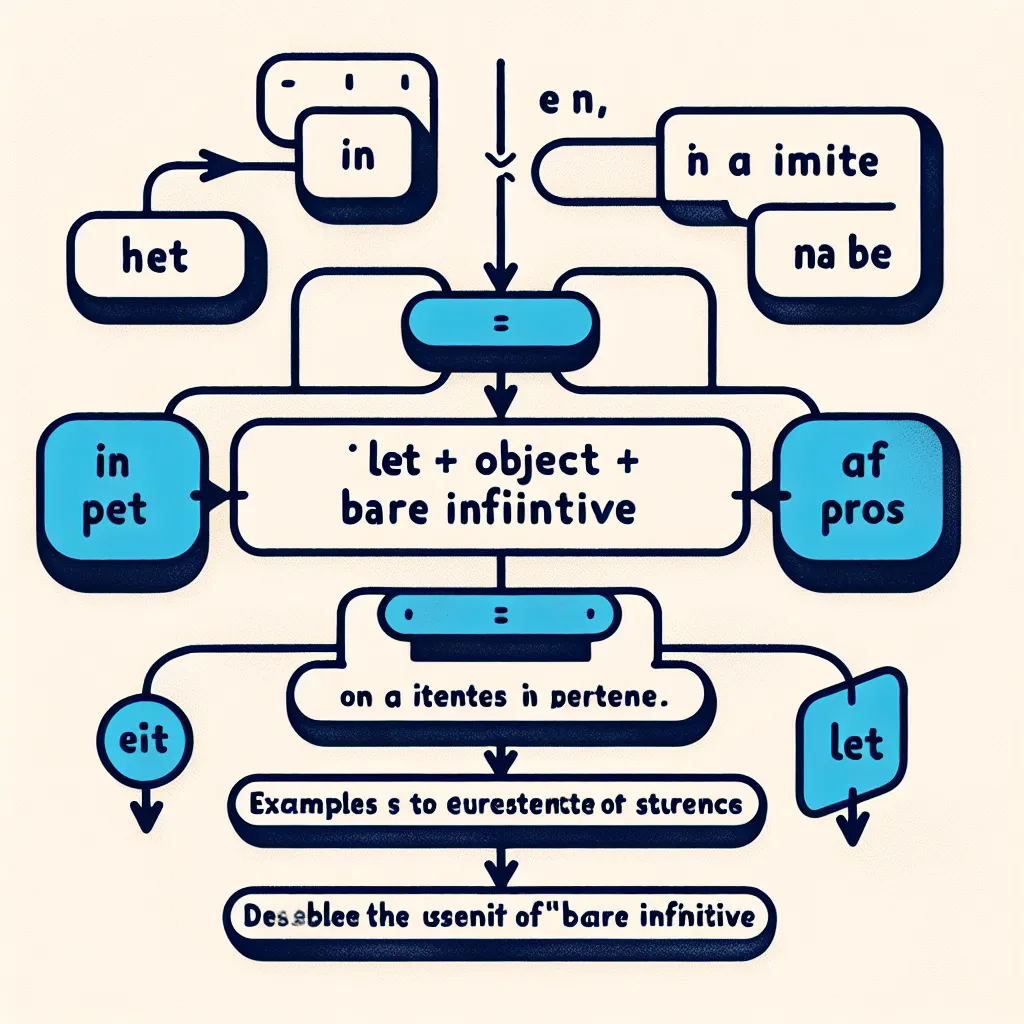The “let + object + bare infinitive” structure is a crucial grammatical pattern that frequently appears in IELTS exams. Understanding and correctly using this structure can significantly enhance your performance across all sections of the test. Let’s delve into this construction and explore how to effectively apply it in your IELTS preparation and exam.
Examples:
- Let me explain the concept. (Speaking)
- The teacher let us leave early. (Writing)
- Don’t let this opportunity pass you by. (Listening)
- The manager let her team handle the project independently. (Reading)
- Let them know about the change in schedule. (Speaking)
In each of these examples, “let” is followed by an object (me, us, this opportunity, her team, them) and then a bare infinitive (explain, leave, pass, handle, know). This structure is used to express permission or allowing something to happen.
Understanding the “Let + Object + Bare Infinitive” Structure
The “let + object + bare infinitive” structure is a causative form used to express permission or to describe allowing someone to do something. It’s a common construction in English and appears frequently in IELTS materials across all four skills: Listening, Reading, Writing, and Speaking.
Formula and Grammatical Analysis
The basic formula for this structure is:
Let + Object + Bare Infinitive
- Let: The main verb, always in its base form.
- Object: The person or thing being allowed or permitted to do something.
- Bare Infinitive: The action verb without ‘to’.
This structure is unique because it uses a bare infinitive (verb without ‘to’) instead of the more common ‘to + infinitive’ structure seen with many other verbs.

Usage in Different IELTS Sections
-
IELTS Listening:
You might hear this structure in conversations or monologues. For example:
“The supervisor let the team leave early due to the snowstorm.” -
IELTS Reading:
This structure often appears in various text types. For instance:
“The new policy lets employees work from home twice a week.” -
IELTS Writing:
You can use this structure to express ideas more concisely in your essays:
“Governments should let citizens decide on major policy changes through referendums.” -
IELTS Speaking:
This structure is useful for expressing personal experiences or opinions:
“My parents always let me choose my own career path.”
Applying the Structure in IELTS Tasks
Writing Task 2 Sample
In an IELTS Writing Task 2 essay about education, you might use this structure as follows:
“Modern educational approaches let students take more control of their learning process. By allowing this autonomy, schools let young people develop critical thinking skills and self-discipline. However, it’s important not to let this freedom compromise the quality of education. Teachers should still guide students and not let them neglect essential subjects.”
Speaking Part 2 Sample
In a Speaking Part 2 task where you describe a time you helped someone, you could say:
“I once helped my younger sister with her science project. I let her come up with the main idea, but I guided her through the research process. I didn’t want to let her struggle too much, so I let her ask me questions whenever she needed clarification. In the end, I let her present the project to me as practice, which really boosted her confidence.”
Advanced Usage for Higher Band Scores
To achieve higher band scores in IELTS, it’s crucial to use this structure accurately and in varied contexts. Here are some advanced applications:
-
Negative form: “Don’t let” or “Never let”
Example: “We should never let fear prevent us from pursuing our dreams.” -
Question form:
Example: “Why did you let him take your car without permission?” -
Passive voice (less common but impressive if used correctly):
Example: “Children are often let off easily for minor offenses.” -
Idiomatic expressions:
- “Let’s face it” (used to introduce a fact that may be unpleasant)
- “Let alone” (meaning “not to mention” or “much less”)
Example: “Let’s face it, most people can’t afford luxury cars, let alone private jets.”
-
With modals (for hypothetical situations):
Example: “If I were the manager, I would let employees choose their own working hours.”
Using these advanced forms can demonstrate a higher level of language proficiency, potentially boosting your band score in both Writing and Speaking tasks.
Common Mistakes to Avoid
-
Adding ‘to’ after ‘let’:
Incorrect: “She let to her friend borrow her book.”
Correct: “She let her friend borrow her book.” -
Using the wrong tense after ‘let’:
Incorrect: “The teacher let us went home early.”
Correct: “The teacher let us go home early.” -
Confusing ‘let’ with ‘make’ or ‘allow’:
While ‘let’ and ‘allow’ are often interchangeable, ‘make’ has a different meaning (force or require).
Example: “The boss let (allowed) us leave early” vs “The boss made us stay late” -
Overusing the structure:
While it’s a useful structure, overusing it can make your speech or writing sound repetitive. Vary your language by using synonyms or alternative structures where appropriate. -
Forgetting the object:
Incorrect: “Let’s go to the party.”
Correct: “Let us go to the party.” (Note: “Let’s” is a contraction of “let us” and is correct in informal speech)
Conclusion
Mastering the “let + object + bare infinitive” structure can significantly enhance your IELTS performance. It allows for clear and concise expression of permission and enablement, which are common themes in the exam. Practice using this structure in various contexts, and remember to vary your language use to demonstrate a wide range of grammatical knowledge. As you prepare, try incorporating this structure into your practice essays, speaking responses, and even as you analyze reading and listening materials. With consistent practice, you’ll find yourself using this structure naturally and effectively in your IELTS exam.
For further practice, consider how you might use this structure in topics like technology advancements, environmental policies, or cultural changes – all common themes in IELTS tasks. Remember, the key to success is not just understanding the structure, but applying it appropriately and accurately in your responses.